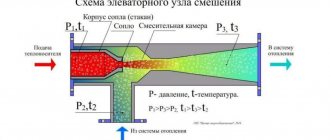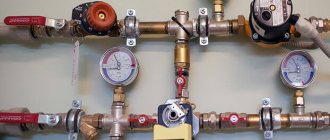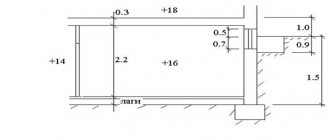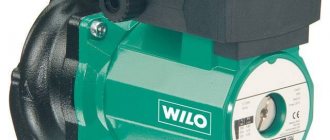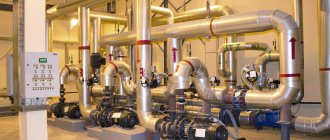Most citizens do not think about what heat loss is and why they need to be known, considering this information unnecessary for themselves. At the same time, residents of apartment buildings (MCDs) complain about the cold in their apartments in winter, attributing this only to insufficient heating. We invite you to understand together the causes of temperature discomfort in cold weather and learn about the causes of heat loss in the apartment. Knowing how to calculate this value will help ensure not only comfortable living, but also financial savings.
Heat loss in the house
Energy saving is now the most popular topic on the Internet. Of course, everyone wants to save money, especially in the current economic conditions. Calculation of heat losses plays the most important role in this case. Heat loss in the simplest sense is the amount of heat that is lost by a room, house or apartment. They are measured in Watts. Heat losses occur in the house due to the difference in external and internal air temperatures.
During the transitional and cold period of the year, the temperature on the streets drops, and the temperature difference between indoor air and outdoor air increases. And as we already mentioned, no one has canceled the Second Law of Thermodynamics, so the heat from your houses and apartments tends to leave it and warm the cold environment. To reduce these heat losses, houses are insulated in various forms, from polystyrene foam and ventilated facades to modern thermal insulation materials in the form of putty. The main task in our profession is to maintain comfortable microclimate parameters in the room. And first of all, we calculate heat losses to compensate for them.
Factors influencing heat loss
Thermal processes correlate well with electrical processes: the role of voltage is the temperature difference, heat flow can be considered as current, but for resistance you don’t even need to come up with your own term. The concept of least resistance, which appears in heating engineering as cold bridges, is also completely true.
If we consider an arbitrary material in cross-section, it is quite easy to establish the heat flow path at both the micro and macro levels. As the first model, we will take a concrete wall, in which, due to technological necessity, through fastenings are made with steel rods of arbitrary cross-section. Steel conducts heat slightly better than concrete, so we can distinguish three main heat flows:
- through the thickness of concrete
- through steel rods
- from steel bars to concrete
Heat loss through cold bridges in concrete
The model of the last heat flow is the most interesting. Since the steel rod heats up faster, closer to the outside of the wall there will be a temperature difference between the two materials. Thus, the steel not only “pumps” heat outward on its own, it also increases the thermal conductivity of the adjacent masses of concrete.
In porous media, thermal processes proceed in a similar way. Almost all building materials consist of a branched web of solid matter, the space between which is filled with air. Thus, the main conductor of heat is a solid, dense material, but due to its complex structure, the path along which heat spreads turns out to be larger than the cross section. Thus, the second factor that determines thermal resistance is the heterogeneity of each layer and the enclosing structure as a whole.
Reducing heat loss and shifting the dew point into the insulation during external wall insulation
The third factor affecting thermal conductivity is the accumulation of moisture in the pores. Water has a thermal resistance 20–25 times lower than that of air, so if it fills the pores, the overall thermal conductivity of the material becomes even higher than if there were no pores at all. When water freezes, the situation becomes even worse: thermal conductivity can increase up to 80 times. The source of moisture, as a rule, is room air and precipitation. Accordingly, the three main methods of combating this phenomenon are external waterproofing of walls, the use of vapor barrier and calculation of moisture accumulation, which must be carried out in parallel with the prediction of heat loss.
Why do heat loss calculations?
When do they calculate heat loss in a house? Calculation of heat loss is mandatory when designing heating systems, ventilation systems, and air heating systems. Design temperatures are taken from regulatory documents. The external air temperature value corresponds to the external air temperature of the coldest five-day period. The internal temperature is taken either from the one you want or from the norms; for residential premises it is 20+-2°C.
The initial data for the calculation are: external and internal air temperature, the design of walls, floors, ceilings, the purpose of each room, and the geographic area of construction. All heat losses directly depend on the thermal resistance of the enclosing structures; the greater it is, the less heat loss.
To ensure comfortable living conditions for people in a room, it is necessary that the heat balance equation be true
Qп+ Qо+ Qс+ Qк= Qср+ Qос+ Qр+ Qpeople,
where Qп – heat loss through the floor, Qо – heat loss through the windows, Qс – heat loss through the wall, Qк – heat loss through the roof, Qср – heat gain from solar radiation, Qос – heat gain from heating systems, Qр – heat gain from appliances, Qpeople – heat gain from people .
In practice, the equation is simplified and all losses are compensated by the heating system, regardless of water or air.
What activities are planned based on the results of heat loss analysis?
If heat leaks are detected, a decision is made to overhaul the building. In order to save energy, external walls are insulated and more powerful and modern heating systems are installed. Better quality windows are installed, with a larger number of double-glazed windows that provide thermal resistance to loss. However, the roof is most often repaired, since it is the most vulnerable place for heat to escape.
If your family, even with “warm floors”, double-glazed windows, a glazed loggia and a modern front door, is freezing, the reason must be sought in leaks of the thermal resource. The calculated data will be the reason for contacting the management company and initiating appropriate actions on its part.
Heat loss calculation
Having received the initial data, designers begin calculations. Let's consider the main types of heat losses and formulas for their calculation. There are heat losses: through walls, through the floor, through windows, through the roof, through ventilation shafts and additional heat losses. Thermal resistance for all structures is calculated using the formula
where αв is the heat transfer coefficient of the inner surface of the fence, W/m2 o C; λi and δi – thermal conductivity coefficient for the material of each layer of the wall and the thickness of this layer in m; αн – heat transfer coefficient of the outer surface of the fence, W/m 2 o s;
Coefficients α are taken from the standards, and are different for walls and ceilings.
First of all, let's look at heat loss through the walls
The design of the walls has the greatest influence on them. Calculated using the formula:
Coef. n-correction factor. Depends on the material of the structures, and n=1 is accepted if the structures are made of piece materials, and n=0.9 for the attic, n=0.75 for the basement floor.
Example: Let's consider heat loss through a 510 mm brick wall with 100 mm mineral wool insulation and a 30 mm decorative finishing ball. Internal air temperature 22ºС, external -20ºС. Let it be 3 m high and 4 m long. The room has one external wall, placement to the South, the area is not windy, without external doors. First you need to know the thermal conductivity coefficients of these materials. From the table above we find out: λk =0.58 W/mºC, λut =0.064 W/mºC, λsht =0.76 W/mºC. After this, the thermal resistance of the enclosing structure is calculated:
Rst = 1/ 23 +0.51/0.58+0.1/0.064+0.03/0.76+ 1/ 8.6 = 2.64 m 2 ºС/W.
For our area, such resistance is not enough and the house needs to be better insulated. But that’s not about that now. Heat loss calculation:
ß is additional heat loss. Next, we will describe their meaning and it will become clear where the number 10 comes from and why divide by 100.
Next comes heat loss through the windows
Everything is simpler here. Calculation of thermal resistance is not necessary, because it is already indicated in the passport of modern windows. Heat loss through windows is calculated according to the same scheme as through walls. As an example, let's calculate the losses through energy-saving windows with a thermal resistance of Ro = 0.87 (m 2 °C/W) of size 1.5 * 1.5 and oriented to the North. Q=1/0.87·2.25·42·1·(15/100+1)=125 W.
Heat loss through ceilings includes heat removal through roof and floor coverings. This is mainly done for apartments where both the floor and ceiling are reinforced concrete slabs. On the top floor only losses through the ceiling are taken into account, and on the first floor only through the basement floor. This is due to the fact that the same air temperature is assumed in all apartments, and heat transfer from apartment to apartment is not taken into account. Recent studies have shown that large heat losses occur through non-insulated junctions between floors and enclosing structures.
The definition of heat leakage through a ceiling is the same as for a wall, but additional heat loss is not taken into account. The coefficient α is taken differently: α in = 8.7 W/(m 2 K) α in = 6 W/(m 2 K), the temperature difference is also the same, because in the basement or in a covered attic the temperature is taken within 4-6ºС . We will not describe the calculation of thermal resistance for the ceiling, because it is determined by the same formula Rst = 1/ αв + Σ ( δі / λі ) + 1/ α. Let's take a ceiling with a resistance of 4.95 and take the air in the attic +4ºС, the ceiling area is 3x4 m, inside 22ºС. Substitute into the formula and get: Q=1/R·FΔt·n·β=1/4.95·12·18·0.9= 40 W.
Junction points of building structures
The compounds disrupt the integrity of the materials. Therefore, corners, joints and abutments are so vulnerable to cold and moisture. The joints of concrete panels become damp first, and fungus and mold appear there. The temperature difference between the corner of the room (the junction of the structures) and the main wall can range from 5-6 degrees, to sub-zero temperatures and condensation inside the corner.
Corner of room window on thermal imager
Clue! At the sites of such connections, craftsmen recommend making an increased layer of insulation on the outside.
Heat often escapes through the interfloor ceiling when the slab is laid across the entire thickness of the wall and its edges face the street. Here the heat loss of both the first and second floors increases. Drafts form. Again, if there is a heated floor on the second floor, the external insulation should be designed for this.
Calculation of heat losses in Excel
The process of calculating heat losses at home takes quite a lot of time, so we created a template for ourselves in Excel with which we make calculations. We decided to share it with you and you can use it by following the link. Here we will write out the instructions for use.
Step 1
Follow the link and open the program file. You will see a table like this:
Step 2
You need to fill in the initial data: room number (if you need it), its name and temperature inside, the name of the enclosing structures and their orientation, the dimensions of the structures. You will see that the area counts itself. If you want to subtract the window area from the walls, you need to adjust the formulas, since we do not know where your windows will be recorded. Our space is being taken away. You also need to fill in the heat transfer coefficient 1/R, temperature difference and correction factor. Unfortunately, they are filled out manually. In the example, we have an office with three external walls; one wall has two windows, another has no windows, and the third has one window. The wall structure will be as in the example where we calculated R, eat k=1/R=1/2.64=0.38. Let the floor be on the ground and divide it into zones; we have two of them and calculate the losses for two zones, then k1 = 1/2.15 = 0.47, k2 = 1/4.3 = 0.23. Let the windows be energy-saving Ro = 0.87 (m 2 °C / W), then k = 1/0.87 = 1.14.
The picture shows that the amount of heat loss is already visible.
Step 3
Unfortunately, additional losses are also filled in manually. You need to enter them as a percentage; the program itself will convert them into a coefficient in the formula. And so, for our example: Walls 3 means +5% heat loss to each wall, the terrain is not spindle therefore +5% to each window and wall, Orientation to the South +5% for structures, to the North and East +10%. There are no external doors, therefore 0, but if there were, the percentages would only be added up to the wall in which there is a door. We remind you that additional heat losses do not apply to the floor or ceiling.
As you can see, the loss of premises has increased. If you already have warm air entering the room, this is the last step. The number written in column Q is your desired heat loss of the room. And this procedure must be carried out for all other premises.
Step 4
In our case, the air is not heated, and in order to calculate the total heat loss, we need to enter the area of our room 18 m2 in column R, and its height 3 m in column S.
This program significantly speeds up and simplifies calculations, even despite the large number of manually entered elements. She helped us more than once. We hope it will become a helper for you too!
Thermal imaging inspection of the heating network
Areas of the object without defects, anomalies and heat losses
The pipelines are completely insulated, heat losses correspond to standard losses.
The pipelines are completely insulated, heat losses correspond to standard losses.
The pipelines are completely insulated, heat losses correspond to standard losses.
The pipelines are completely insulated, heat losses correspond to standard losses.
The pipelines are completely insulated, heat losses correspond to standard losses.
The pipelines are completely insulated, heat losses correspond to standard losses.
The pipelines are completely insulated, heat losses correspond to standard losses.
Thermal imaging examination from RUB 15,000.
Find out in detail
Instruments and controls
The quality control of the thermal insulation of structures was carried out using a “testo 871” thermograph (thermal imager).
During the thermal inspection, the following equipment was additionally used:
- thermohygrometer Testo 622,
- heat flux density and temperature meter ITP-MG4.03 “POTOK”,
- Thermal anemometer Testo 405.
Technical characteristics of Testo 871
| SI name | Thermal imager | |
| Manufacturer | testo 871 | |
| Brand SI | 871 | |
| Serial number | 1008266 | |
| No. in the State Register of Measuring Instruments | 44367-10 | |
| Specifications | ||
| Detector size, pixels | 240×180 | |
| Image quality NETD, mK | 90 | |
| Error | ±2 °C or ±2% | |
| Temperature range, °C | -30…+650 | |
| Operating temperature, °C | -15 … +50 | |
| Probe type | infrared | |
| Image storage type | removable SD memory card | |
Technical characteristics of Testo 622
| SI name | Thermohygrometer | |
| Manufacturer | testo | |
| Brand SI | 622 | |
| Serial number | 39501565/005 | |
| No. in the state register of measuring instruments | 35319-07 | |
| Specifications | ||
| measurement range | 300…1200.0 hPa | |
| Humidity measurement error (at 25±5°С), % | no more than ±3 | |
| Temperature measurement range, °C | -10…+60 | |
| temperature measurement error, °C | no more than ±0.4 | |
| Dimensions | 185 x 105 x 36 mm | |
Technical characteristics of Testo 405
| SI name | Thermal anemometer | |
| Manufacturer | testo | |
| Brand SI | 405 | |
| Serial number | 41518249/410 | |
| Flow rate | ||
| Measuring range | 0 … +99990 m³/h | |
| Thermal anemometer | ||
| Measuring range | 0 … 5 m/s (-20 … 0 °C) 0 … 10 m/s (0 … +50°C) | |
| Error | ±(0.1 m/s + 5% of measured value) (0 … +2 m/s) ±(0.3 m/s + 5% of measured value) (in remaining range) | |
| Permission | 0.01 m/s | |
| Temperature measurement | ||
| Measuring range | -20 … +50 °C | |
| Error | ±0.5 °C | |
| Permission | 0.1 °C | |
| Working temperature | 0 … +50 °C | |
| Dimensions | 490 x 37 x 36 mm |
Dacha.news
It is generally accepted that for central Russia the power of heating systems should be calculated based on the ratio of 1 kW per 10 m 2 of heated area. What does SNiP say and what are the real calculated heat losses of houses built from various materials?
SNiP indicates which house can be considered, so to speak, correct. From it we will borrow building standards for the Moscow region and compare them with typical houses built from timber, logs, foam concrete, aerated concrete, brick and using frame technologies.
How it should be according to the rules (SNiP)
SNiP 23-02-2003 “Thermal protection of buildings” defines the “Normed value of the heat transfer resistance of enclosing structures” of residential premises in the range from 2.1 to 8.2 m 2 °C/W, depending on their position and degree-day. A degree day is a conditional value expressed in the average temperature difference between inside and outside, multiplied by the number of days of the heating season. To find out the standard values of degree-days for the heating period, we turn to Table 4.1 of the Reference Manual for SNiP 01/23/99. If the indoor temperature is maintained at 22 degrees for the Moscow region, we will get a value of 5400, therefore (based on the correspondence table in SNiP 23-02-2003), the desired value of the heat transfer resistance of the walls will be 2.8 m 2 °C / W . This corresponds to the wall of a frame house with mineral wool insulation of thickness
100 mm. From the same table, we take the resistance values for the floor/ceiling (3.7 m 2 °C/W) and windows (0.45 m 2 °C/W). Thus, in a house according to SNiP, the insulation of the roof and floor should be equivalent to 140 mm of mineral wool, and double-glazed windows should be double-chamber with ordinary glass (see thermal conductivity of double-glazed windows).
However, the values we took of 5400 degree-days for the Moscow region are borderline to the value of 6000, according to which, in accordance with SNiP, the heat transfer resistance of walls and roofs should be 3.5 and 4.6 m 2 °C/W, respectively, which is equivalent to 130 and 170 mm of mineral wool with thermal conductivity coefficient λA=0.038 W/(m·°K).
Building regulations
To establish and consolidate standards for heat loss at home, there are codes of practice (SP), norms and regulations (SNiP) used in construction, and GOST:
- SP 131.13330.2012 – on construction climatology;
- SP 50.13330.2010 – on thermal protection of buildings;
- SP 60.13330.2012 – on heating, ventilation and air conditioning in buildings.
- SNiP 2.04.07-86* – on heating networks;
- SNiP 2.08.01-89* – on residential buildings;
- SNiP 2.04.05-91* – on heating, ventilation and air conditioning.
- GOST 22270-76 – on equipment for air conditioning, ventilation and heating;
- GOST 30494-2011 – on microclimate parameters in residential and public buildings;
- GOST 31311-2005 – about heating devices.
The MKD energy passport data must comply with the above technical documentation and be within the regulated standards.
How much heat in kW do you need to heat your house - check it with a calculator!
If we are going to save as much as possible in this or that area of life, then we need to have a good idea of where, in what quantities and what our money is spent on. And one of the most sensitive items of family budget expenditure in our time is utility bills. And if there is relative clarity with electricity costs, since for the most part everything is visible and quite clear, then with heating it is somewhat more complicated.
How much heat do we need to heat our home?
It doesn’t matter what scheme or system is used for these purposes, first of all it is necessary to have information about how much heat we need to heat our home? Yes, the question sounds exactly like that, without moving into the “monetary plane” for now. Yes, we will not be able to predict financial costs until we express the required thermal energy in some understandable quantities. For example, in kilowatts.
That's what we'll do today.
Brief description of the heating network
To cover heat loads, a production heating boiler house is used, the main fuel of which is natural gas.
The boiler room produces
- steam for technological needs - all year round
- hot water for heating needs - during the heating season and
- hot water supply - all year round.
- The project provides for the operation of the heating network according to a temperature schedule of 98/60 degrees. WITH.
The heating system connection diagram is dependent.
Heating networks that ensure the transfer of thermal energy for the heating needs of the entire village and hot water supply to its right-bank part are installed in above-ground and underground versions.
The heating network is branched and dead-end.
The year of commissioning of heating networks was 1958. Construction continued until 2007.
Thermal insulation completed
- glass wool mats 50 mm thick, with a covering layer of rolled material,
- extruded polystyrene foam type TERMOPLEX 40 mm thick, with a covering layer of galvanized sheet and polyethylene foam 50 mm thick.
During operation, some sections of the heating network were repaired with the replacement of pipelines and thermal insulation.
Some general information - what is the required amount of heat?
Very briefly, all this is already known - it just requires a little systematization.
For a modern person to live comfortably, he requires the creation of a certain microclimate, one of the most important components of which is the air temperature in the room. And although “thermal preferences” may vary, we can safely say that for most people this “temperature comfort” zone lies in the range of 18–23 degrees.
But when there is, for example, a negative temperature outside, then natural thermodynamic processes tend to bring everything under the “common bar”, and heat begins to leave the living area. Heat loss is a completely normal phenomenon from a physical point of view. The entire housing insulation system is aimed at minimizing such losses, but it is impossible to completely eliminate them. And hence the conclusion - heating the house is precisely intended to make up for these same heat losses.
There is no escape from heat losses, but it is very important to at least try to reduce them to the possible minimum.
How to determine their quantity?
The simplest way to calculate the required heating power is based on the statement that 100 watts of heat are required for each square meter of area. Or - 1 kW per 10 m².
But even without being an expert, you can think about how such “equalization” is combined with the specifics of specific houses and the premises in them, with the placement of buildings on the ground, with the climatic conditions of the region of residence?
So it is better to use a different, more “scrupulous” calculation method , in which many different factors will be taken into account. It is this algorithm that forms the basis of the calculator proposed below .
Important - calculations are carried out for each heated room of a house or apartment separately. And only at the end the total amount of required thermal energy is calculated. The easiest way would be to create a small table, the rows of which list all the rooms with the data necessary for calculations. Then, if the owner has a plan of his residential property at hand, the calculations will not take much time.
And one more note. The result may seem quite exaggerated. But we must understand correctly - in the end, the amount of heat that is required to replenish heat loss in the most unfavorable conditions is shown. That is, to maintain the indoor temperature of +20 ℃ at the lowest outdoor temperatures characteristic of the region of residence. In other words, at the peak of winter cold the house will be warm.
But such super-frost weather, as a rule, lasts for a very limited time. That is, the heating system will mostly operate at a lower power. This means that there is no particular point in laying down any additional reserve. The operational power reserve will be already impressive.
Below is a calculator , and below it will be placed the necessary brief explanations for working with the program.
Types of heat waste
Each site has its own type of heat waste. Let's look at each of them in more detail.
Boiler room
It contains a boiler that converts fuel and transfers thermal energy to the coolant. Any unit loses part of the generated energy due to insufficient fuel combustion, heat escape through the boiler walls, and problems with purge. On average, boilers used today have an efficiency of 70-75%, while newer boilers will provide an efficiency of 85% and the percentage of losses is significantly lower.
Additional influence on energy waste is exerted by:
- lack of timely adjustment of boiler modes (losses increase by 5-10%);
- discrepancy between the diameter of the burner nozzles and the load of the heating unit: heat transfer decreases, fuel does not burn completely, losses increase by an average of 5%;
- insufficiently frequent cleaning of the boiler walls - scale and deposits appear, operating efficiency decreases by 5%;
- the absence of monitoring and adjustment means - steam meters, electricity meters, heat load sensors - or their incorrect settings reduce the efficiency factor by 3-5%;
- cracks and damage to the boiler walls reduce efficiency by 5-10%;
- the use of outdated pumping equipment reduces boiler room repair and maintenance costs.
Losses in pipelines
The efficiency of the heating main is determined by the following indicators:
- Efficiency of pumps that move coolant through pipes;
- quality and method of laying the heating pipe;
- correct settings of the heating network, on which heat distribution depends;
- pipeline length.
With proper design of the heating route, the standard losses of thermal energy in heating networks will be no more than 7%, even if the energy consumer is located 2 km from the place of fuel production. In fact, today in this section of the network, heat loss can reach 30 percent or more.
Losses of consumer goods
You can determine excess energy waste in a heated room if you have a meter or meter.
The reasons for this type of loss may be:
- uneven distribution of heating throughout the room;
- the heating level does not correspond to weather conditions and time of year;
- no recirculation of hot water supply;
- lack of temperature control sensors on hot water boilers;
- dirty pipes or internal leaks.
Calculator for calculating the required thermal power for space heating
Explanations for calculations
We sequentially enter the data into the fields of the calculator.
- First of all, we will determine the climatic features - indicating the approximate minimum temperature characteristic of the region of residence in the coldest decade of winter. Naturally, we are talking about normal temperatures for the region, and not about some “records” in one direction or another.
By the way, of course, this field will not change when calculating for all rooms of the house. In other fields, variations are possible.
- Next comes a group of two fields, which indicate the area of the room (exactly) and the height of the ceilings (select from the list).
- The following group of data takes into account the location of the room:
— Number of external walls , that is, in contact with the street (selection from the list, from 0 to 3).
— The location of the external wall relative to the cardinal direction. There are walls that regularly receive a charge of thermal energy from the sun's rays. But the northern wall, for example, never sees the sun at all.
- If in the area where the house is located, there is a predominance of a certain direction of the winter wind (stable wind rose), then this can also be taken into account. That is, indicate whether the outer wall is on the windward, leeward or parallel side to the wind direction. If there is no such data, then we leave it by default, and the program will calculate as for the most unfavorable conditions.
— Next, it is indicated how insulated the walls are . Select from three proposed options. More precisely, even of the two, since in a house with generally uninsulated walls, starting heating is absolute nonsense.
- Two similar fields of piglets indicate what the room is adjacent to “vertically”, that is, what is located above and below. This will help to estimate the size of heat loss through floors and ceilings.
- The next group concerns indoor windows. What is important here is their number, size, and type, including the features of double-glazed windows. Based on the totality of this data, the program will develop a correction factor to the calculation result.
- Finally, the amount of heat loss is seriously affected by the presence in the room of doors facing the street, onto the balcony, into a cold entrance, etc. If the doors are used regularly throughout the day, then any opening of them is accompanied by an influx of cold air. It is clear that this requires compensation in the form of additional thermal power.
All data has been entered - you can press the button. As a result, the user will immediately receive the desired value of thermal power for a specific room.
As already mentioned, the sum of all values will give the result for the entire house (apartment) as a whole, in kilowatts.
Software for heating system design
Using computer programs, you can calculate all the materials spent on heating, as well as make a detailed floor plan of communications showing radiators, specific heat capacity, energy costs, and components.
The company offers basic CAD for design work of any complexity - ZWCAD 2022 Professional. In it you can not only design a heating system, but also create a detailed diagram for the construction of the entire house. This can be realized thanks to the large functionality, number of tools, as well as work in two- and three-dimensional space.
Before building a house, do a thermal engineering calculation. This will help you not make a mistake with the choice of equipment and the purchase of building materials and insulation.
Checking windows for leaks
Up to 40% of heat escapes through windows. If the windows are old, wooden and it is not possible to replace them with modern double-glazed windows, then to insulate them you can use insulation from available thermal insulation materials. Even duct tape will do. It is also necessary to check the window closing mechanisms and adjust if necessary. It is recommended to use three-chamber double-glazed windows for glazing windows.
Selecting the type of heating system
In accordance with a well-established tradition, it is customary to use a liquid coolant in autonomous heating, as in centralized heating. In the case of a private house, this can only be justified by stereotypical thinking: in an autonomous heating system there is no point in using a medium with a large heat capacity, as in a centralized one, where a lot of heat is lost on the way from the heat source (boiler room) to the consumer.
In an “autonomous” system, if the heat generator is located directly in the home, heat can be distributed using air, which, unlike water, cannot boil, flood the floor or cause corrosion of metal surfaces.
Radiator heating in the apartment
But in an apartment, water heating, as a rule, is the only possible choice, since air heating, due to the large cross-section of the air ducts, has to be installed at the design stage of the building.
Having dealt with the coolant, we should answer the second question: how will the heat in our liquid heating system be transferred from the coolant to the room. There are two options:
- through radiators;
- through the “warm floor” (TP) system.
From the point of view of operational characteristics, TP is definitely better:
- It is more economical because it operates in a low-temperature mode, and heat loss, as is known, is proportional to the temperature difference. TP does not provide for contact of heated air with external walls, through which the heat escapes to the street.
- Provides maximum comfort: it is pleasant to walk on the floor barefoot, while heated air rises through the living area, immediately warming the residents. The radiator “releases” heat primarily to the ceiling, generously heating the outer wall.
- It is installed hidden, so that the interior of the room remains immaculate.
The fact that the TP can only function with a circulation pump (CP) should not confuse us: today heating with natural circulation can only be found in some remote village, where in winter you have to sit for a long time without electricity. In the city, both TP and radiator heating should be equipped with central heating, because:
- circulation of coolant at a low temperature becomes possible (relevant for the off-season);
- By the time the coolant reaches the radiator farthest from the boiler, it does not have time to cool down much;
- The heat generator operates in a gentle mode, since it only has to heat up the coolant slightly.
Underfloor heating
But TP also has disadvantages, and serious ones:
- installation of the system is complex and is possible only at the stage of major renovation of the apartment;
- the height of the room is significantly reduced;
- heat transfer is limited (the floor cannot be made too hot).
Due to limited heat transfer, TP is usually used as a supplement to radiator heating. The operation of circuits with different temperatures (for the TP - about 330C, for the radiator - about 800C) is ensured by the use of a mixing unit. It is installed at the inlet to the transformer substation, and, as necessary, automatically adds hot coolant to it in small portions.
The heated floor must be equipped with its own circulation pump.
Heat loss measurement values
Enclosing structures perform a barrier function for heat and do not allow it to freely escape outside. This effect is explained by the thermal insulation properties of the products. The quantity used to measure thermal insulation properties is called heat transfer resistance. This indicator is responsible for reflecting the temperature difference when the nth amount of heat passes through a section of enclosing structures with an area of 1 m2. So, let's figure out how to calculate heat loss at home.
The main quantities necessary to calculate the heat loss of a house include:
- q is a value indicating the amount of heat leaving the room to the outside through 1 m2 of the barrier structure. Measured in W/m2.
- ∆T is the difference between the temperature in the house and outside. It is measured in degrees (oC).
- R – heat transfer resistance. It is measured in °C/W/m² or °C·m²/W.
- S – area of the building or surface (used as needed).
Air infiltration or building ventilation
All buildings, especially residential buildings, have the ability to “breathe”, that is, to be ventilated in various ways. This is due to the creation of rarefied air in the premises due to the installation of exhaust ducts in the structures of the house or chimneys. As you know, ventilation ducts are created in areas with increased emissions of contaminants, such as kitchens, bathrooms and restrooms.
That is, with proper air exchange, supply air enters the room through a window, ventilation valve or supply grille and is removed in kitchens and bathrooms.
When calculating heat loss, knowing which method of ventilation of residential premises will be chosen is of fundamental importance:
- Mechanical ventilation device with heated supply air.
- Infiltration is unorganized air exchange through leaks in walls, when windows are opened, or when using pre-installed air valves in wall construction or double-glazed windows.
If a balanced ventilation system is used in a residential building (when the volume of supply air is greater than or equal to the exhaust air, that is, any breakthrough of cold air into the living spaces is excluded), the air entering the living spaces is preheated in the ventilation unit. In this case, the power required to heat the ventilation is taken into account when calculating the power of the boiler equipment.
The ventilation heat load is calculated using the formula:
Qvent= c*p*L*(t1-t2) where, Q is the amount of heat required to heat the supply air, W; c – heat capacity of air, J/kg*deg p – air density, kg/m3 L – supply air flow rate, m3/hour t1 and t2 – initial and final air temperatures, deg.
If there is no organized air exchange in residential premises, then when calculating the heat loss of a building, the heat expended by the heating system to heat the infiltration air is taken into account. In this case, the heating of the air entering the premises is carried out by radiators of heating systems, that is, it is taken into account in their thermal load.
If sealed double-glazed windows without built-in air valves are installed in the premises, then heat losses due to air heating are nevertheless taken into account. This is due to the fact that in the case of short-term ventilation, the incoming cold air still needs to be heated.
For more comfortable ventilation, a supply wall valve is built in.
The amount of infiltration thermal energy is taken into account using several methods, and in the heat balance of the building the largest of the values is taken into account.
For example, the amount of heat to heat the air entering the premises to compensate for natural exhaust is determined by the formula:
Qinf=0.28*L*p*c*(tad-tpom), where, s – air heat capacity, J/kg*deg p – air density, kg/m? tout – outside air temperature, degrees, troom – design room temperature, degrees, L – amount of infiltration air, m?/hour.
The amount of air entering residential premises in winter is, as a rule, determined by the operation of natural exhaust systems, therefore in one case it is taken to be equal to the volume of extracted air.
The amount of hood in residential premises is determined in accordance with SNiP 41-01-2003 according to standard indicators for removing air from stoves and sanitary appliances.
- From a kitchen stove - electric 60 m?/hour or gas 90 m?/hour;
- From the bath and toilets 25 m?/hour
In the second case, this infiltration rate is determined based on the sanitary standard of fresh outdoor air, which must enter the premises to ensure the optimal and high-quality composition of the air environment in residential premises. This indicator is determined by the specific characteristic: 3 m?/hour per 1 m? living space.
The maximum air flow and, accordingly, the greater amount of heat loss due to infiltration are taken as the calculated value.
Vulnerable areas of the floor
An uninsulated ceiling transfers a significant portion of the heat to the foundation and walls. This is especially noticeable if the heated floor is installed incorrectly - the heating element cools down faster, increasing the cost of heating the room.
Floor on thermal imager
To ensure that the heat from the floor goes into the room and not outside, you need to make sure that the installation follows all the rules. The main ones:
- Protection. A damper tape (or foil polystyrene sheets up to 20 cm wide and 1 cm thick) is attached to the walls around the entire perimeter of the room. Before this, the cracks must be eliminated and the wall surface leveled. The tape is fixed as tightly as possible to the wall, isolating heat transfer. When there are no air pockets, there are no heat leaks.
- Indent. There should be at least 10 cm from the outer wall to the heating circuit. If the heated floor is installed closer to the wall, then it begins to heat the street.
- Thickness. The characteristics of the required screen and insulation for underfloor heating are calculated individually, but it is better to add a 10-15% margin to the obtained figures.
- Finishing. The screed on top of the floor should not contain expanded clay (it insulates heat in the concrete). The optimal thickness of the screed is 3-7 cm. The presence of a plasticizer in the concrete mixture improves thermal conductivity, and therefore the transfer of heat into the room.
Serious insulation is important for any floor, and not necessarily with heating. Poor thermal insulation turns the floor into a large “radiator” for the ground. Is it worth heating it in winter?!
Important! Cold floors and dampness appear in the house when the ventilation of the underground space is not working or not done (vents are not organized). No heating system can compensate for such a deficiency.
